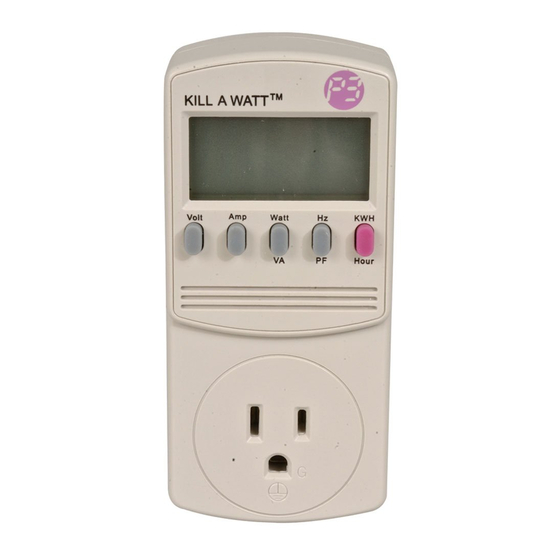Table of Contents
Advertisement
Quick Links
Using the Kill A Watt
Getting Started
The LCD shows all meter readings: voltage (Volt),
current (Amp), watts (Watt), kilowatt-hours (KWH),
frequency (Hz), power factor (PF), and volt amps
(VA).
Step 3 - Calculate the Results
Identify the kilowatt-hours (KWH) used for a single hour.
Example: The meter was plugged in for 02:00 hours and used .20 KWH in that time. To
determine the use for a single hour, divide .20 by 2 hours. .20
Identify your power rate by looking on your power bill.
Multiply the KWH used in 1 hour by the Cost per hour of use to get the Cost Per Hour.
Example: .10 x 8¢ = .008
Multiply the Cost Per Hour by the number of hours the appliance is used per month to get the esti-
mated cost per month.
Example: .008 x 720 hours = $5.76
The appliance used in the example would use approximately $69.12 per year in electrical costs.
Plug the meter into the wall and plug the appliance into the meter.
Once the meter is plugged in, it will start to accumulate KWH and
record the powered duration time (hour). The pink button is a
toggle function key. When pressed, it will alternate between KWH
used since being plugged in and the number of Hours the meter has
been plugged in.
Before unplugging, record the KWH and Hours from the meter. The
meter resets to zero when unplugged, so it is important to record
before unplugging. Display the KWH and Hours of duration by
using the pink KWH/Hours button.
The time (duration) will initially be displayed as Hours:Minutes
(example: 02:30 for 2 hours and 30 minutes).
Meter
™
2 = .10
Advertisement
Table of Contents

Summary of Contents for P3 International Kill A Watt
-
Page 1: Getting Started
Using the Kill A Watt Meter ™ Getting Started The LCD shows all meter readings: voltage (Volt), current (Amp), watts (Watt), kilowatt-hours (KWH), frequency (Hz), power factor (PF), and volt amps (VA). Step 1 - Plug it In Plug the meter into the wall and plug the appliance into the meter. - Page 2 Using the Kill A Watt™ Meter - Small Appliances Getting Started Small appliances will use less power than a large appliance. To measure an appliance that is not plugged in for long periods of time, use Watts instead of KWH.








Need help?
Do you have a question about the Kill A Watt and is the answer not in the manual?
Questions and answers